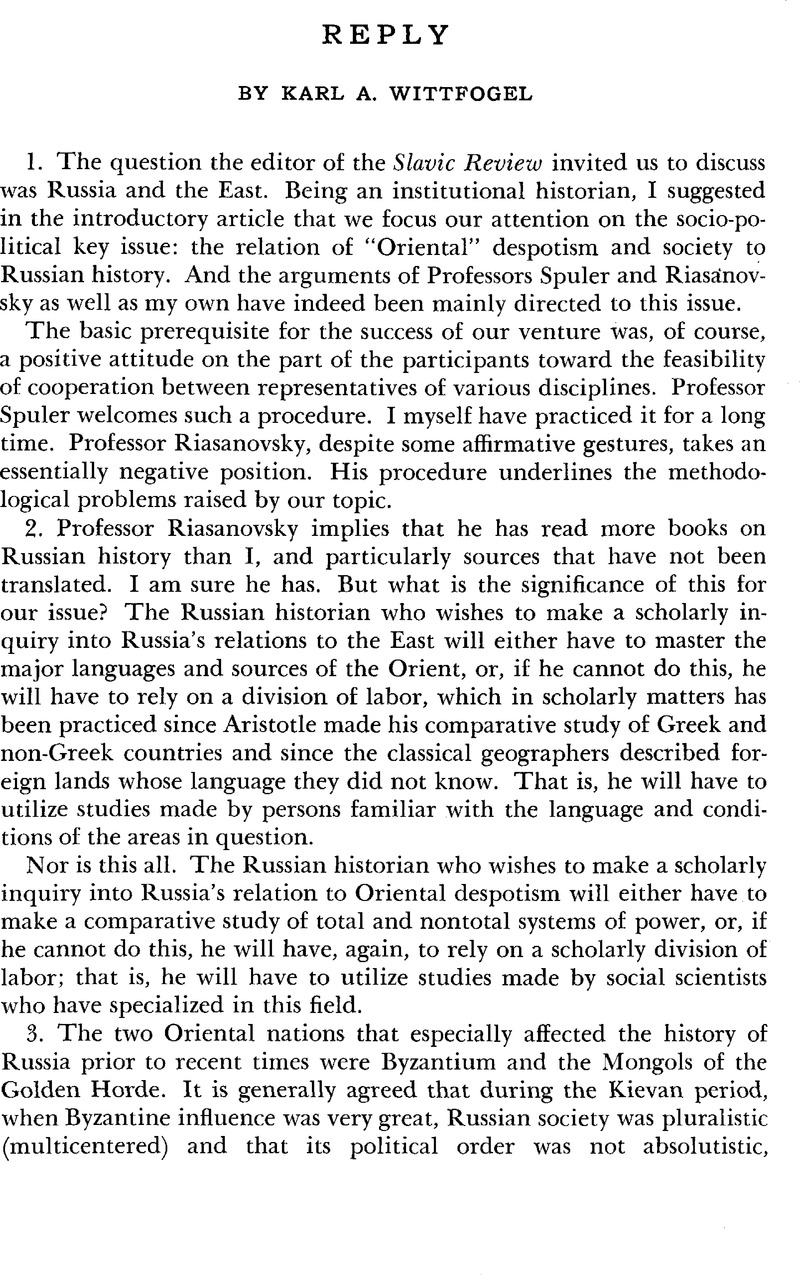Article contents
Abstract

- Type
- Discussion
- Information
- Copyright
- Copyright © Association for Slavic, East European, and Eurasian Studies. 1963
References
1 Riasanovsky, Nicholas V., A History of Russia (New York, 1963), p. 81.Google Scholar
2 See “Qāra-Khitay” by Karl A. Wittfogel and Fúng Chia-shêng, with the assistance of Karl H. Menges, Appendix V to History of Chinese Society, Liao, pp. 619 ff.
3 Spuler, Die Mongolen in Iran.
4 Pelliot, Notes sur VHistoire de la Horde d'or, pp. 7-8.
5 Riasanovsky, op. cit., p. 82.
6 For a documented comparison of the peculiarities and historical changes of some major aspects of Byzantine institutions, including the pronoia, with tsarist Russia, see Wittfogei, Oriental Despotism, pp. 120, 129, 147, 174 ff., 178, 187, and 276-77.
7
![]() lecture 32).
lecture 32).
8 In addition to the evidence given in my introductory article and Oriental Despotism, see Kovalevsky's statement that Russia possessed “an Oriental and despotic state“; Maxime Kovalewsky, Institutions politiques de la Russie, p. iii.
9 Cf. Sumner's statement that tsarism was rooted in the “ideas and ritual” of Byzantium and “the fact and practice of the Tatar Khans“; Sumner, B. H., A Short History of Russia (rev. ed.; New York, 1949), pp. 82–83.Google Scholar
10 See Wittfogel, Oriental Despotism, pp. 86-100; also pp. 190-91, 274, 181 ff., 284-85, 318-19, 346-47, and 362.
11 In 1931 I outlined these diversities and their ecological foundations with regard to traditional China in Wirtschaft und Gesellschaft Chinas, Erster Teil, Produktivkräfte, Produktions- und Zirkulalionsprozess (Leipzig, 1931), pp. 61-93, 187-300, 410-56. Despite the growing interest in the hydraulic problem, comparatively little has been done since to enlarge our knowledge of this vital aspect of the various hydraulic civilizations.
12 Wittfogel, Oriental Despotism, p. 53. For a summary of recent studies of Iranian waterworks (including ancient dams and reservoirs and complex systems of qānāts administered by mirābs) see Henri, Goblot, “Dans l'ancien Iran, les techniques de l'eau et la grande histoire,” Annates: Économies, Sociétés, Civilisations, XVIII, No. 4 (May-June, 1963), 499–520.Google Scholar
- 2
- Cited by


